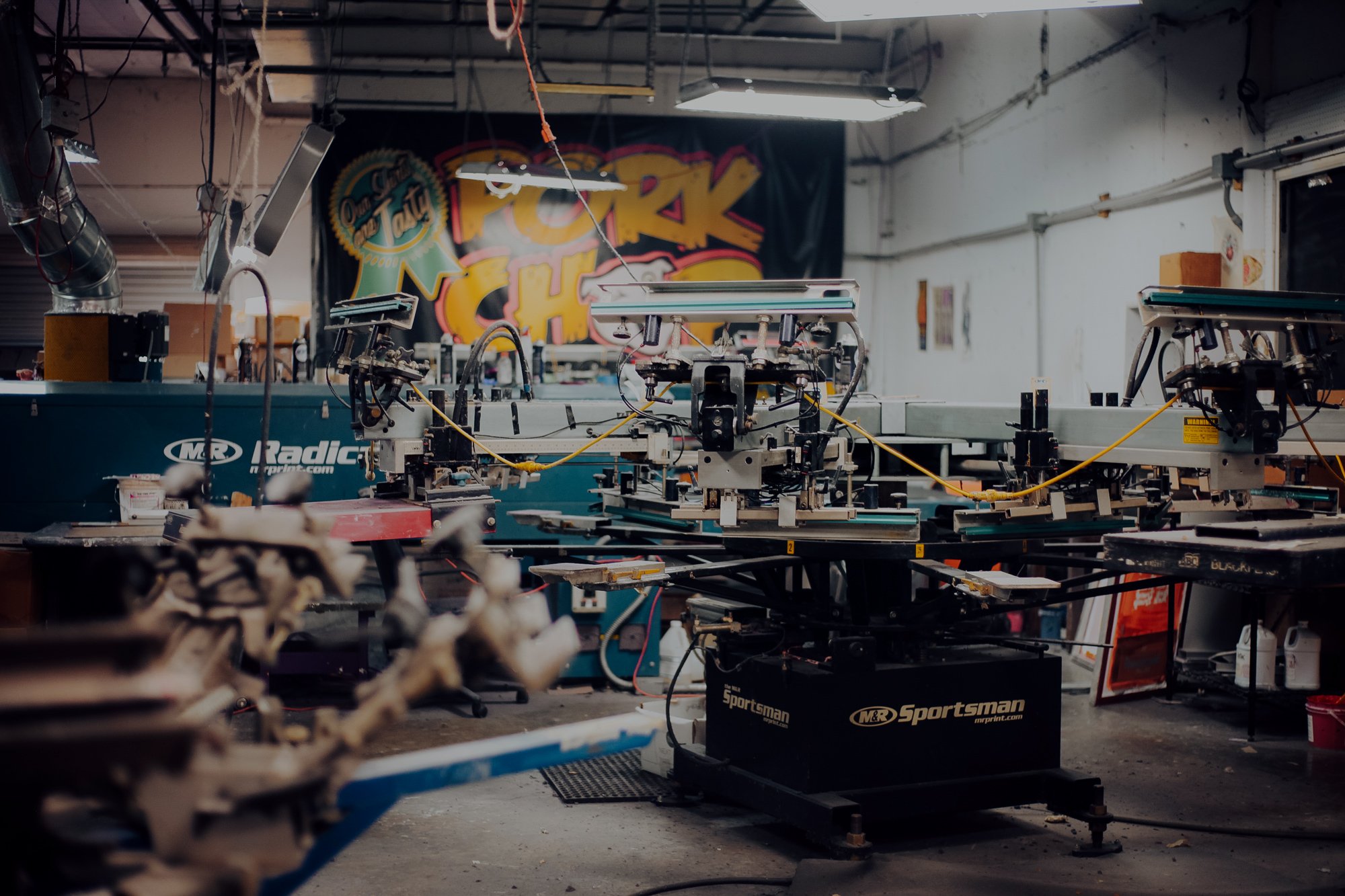Display Printing Uncovered: Whatever You Need to Understand About T-Shirt and Garment Printing Techniques
If you've ever wondered how those vivid layouts finish up on your favorite tees, you're in the best place. Display printing is an interesting approach that incorporates art with technique, using endless possibilities for creative thinking. Comprehending the fundamentals, from equipment to ink options, can substantially affect your outcomes. All set to check out the crucial aspects that make screen printing an art kind? Allow's reveal the details that can boost your tasks.
The Fundamentals of Screen Printing: How It Functions
When you plunge right into display printing, you'll uncover it's both an art and a science. At its core, display printing involves developing a stencil, or display, that enables ink to pass with just in details areas (screen printing kit). You start by choosing your layout and preparing your display with a light-sensitive emulsion. When you subject this solution to light, it hardens, leaving your layout as an unfavorable room.
Placement the display over the textile, after that utilize a squeegee to press ink via the display onto the garment. Each step is important, and mastering them will certainly raise your display printing skills, changing easy garments into distinct, expressive pieces.
Kinds Of Display Printing Strategies
Once you understand the basics of screen printing, it's time to explore the numerous strategies that can boost your layouts. One prominent approach is traditional display printing, where ink is pushed through a stenciled screen.
An additional choice is plastisol printing, known for its resilience and vibrant shades, making it a favorite for lots of brands. Experiment with halftone printing to develop gradient impacts and detailed designs.
Important Tools for Screen Printing
To achieve spectacular lead to display printing, having the appropriate tools is fundamental. You'll need a durable display printing frame, which holds the mesh that moves your style onto the garment. Next, purchase high-grade squeegees; these are necessary for using ink uniformly across the display. You'll also need an excellent direct exposure unit to create your displays, along with a washout cubicle for cleansing them after use. A reputable heat resource, like a conveyor clothes dryer or warm press, is vital for treating your prints to guarantee longevity. Don't forget an appropriate office, furnished with tables and storage space for your materials. Finally, safety gear, such as masks and gloves, will keep you safe from chemicals and inks. With the right devices, you'll be well on your method to generating professional-quality prints.
Choosing the Right Inks and Products
When picking inks and materials for screen printing, you require to consider the sort of ink that functions ideal for your task. Consider fabric compatibility to ensure your layouts look last and fantastic long. Also, discover environmentally friendly ink options to make your printing process extra sustainable.
Kinds of Screen Inks
Choosing the appropriate display ink is crucial for attaining lively, sturdy prints that meet your project's requirements. There are a number of kinds of screen inks to analyze. Specialized inks, such as metallic or glow-in-the-dark, can add special results to your layouts.

Textile Compatibility Factors To Consider
Recognizing textile compatibility is crucial for achieving high-grade screen prints, especially since different materials respond distinctly to various inks. Constantly check your inks on sample textile to guarantee they adhere effectively and keep shade honesty. Furthermore, keep in mind that fabric weight and texture can affect the final end result, so choosing the best ink and product combo is vital for your project's success.
Eco-Friendly Ink Options
Green inks are ending up being a prominent option for screen printers that wish to minimize their ecological impact while maintaining quality. When choosing inks, take into consideration water-based inks, which are much less hazardous and simpler to tidy up contrasted to typical solvents. These inks bond well with fabrics, providing lively outcomes without toxic chemicals. You may likewise explore eco-solvent inks that utilize less unpredictable organic compounds (VOCs), making them a more secure option for both your wellness and the earth.
Additionally, seek inks made from renewable resources, such as soy or vegetable-based alternatives. By picking the right inks and products, you'll not just develop spectacular layouts however likewise add to a much more lasting printing procedure. Make the switch, and your prints will certainly show your dedication to the environment!
Preparing Your Layout for Screen Printing

Submit Layout Requirements
To guarantee your layout looks sharp and vivid on material, you'll need to pay close interest to file style demands for screen printing. Make certain your style has a transparent background to protect against undesirable white edges on your prints. Maintain color settings in mind; CMYK is common for screen printing, so convert your RGB designs as necessary.
Shade Splitting Up Methods
Shade splitting up is a necessary step in preparing your style for display printing, and grasping it can greatly enhance your print high quality. You'll need to damage your design right into specific colors, as each shade requires a separate screen during printing. This accuracy not just guarantees precise color depiction but also simplifies the printing procedure.
Resolution and Size
Attaining the most effective outcomes in screen printing begins with assuring your layout has the ideal resolution and dimension. Preferably, your art work ought to go to least 300 DPI (dots per inch) for sharp, clear prints. If you utilize lower resolution, your final product might look pixelated and less than professional.
When it comes to size, consider the dimensions of your print location. Design your art work to match the final print dimension, ideally producing it in the real measurements you'll be printing. By doing this, you'll prevent any type of unforeseen scaling issues.
Constantly inspect your style in both vector and raster layouts. Vector graphics can be scaled without shedding high quality, making them ideal for display printing. Preparing correctly will guarantee your style looks outstanding on every garment!
Step-by-Step Display Printing Process
Display printing is a dynamic procedure that enables you to create dynamic designs on different surface areas. To start, you'll need a display, emulsion, and your selected ink. Prepare your screen by cleansing it thoroughly. Next, use the emulsion evenly and allow it dry in a dark area. Once completely dry, expose your display to light with your design positioned on it, which will certainly solidify the screen printing kit solution where the light hits, creating a stencil - screen printing kit.
After rinsing the unexposed solution, your screen is prepared. Set it up on your printing surface and straighten your garment underneath it. Pour ink onto the display and make use of a squeegee to push the ink with the stencil onto the textile. Raise the display meticulously and let the print completely dry. Ultimately, cure the ink using warm to ensure sturdiness. That's it! You have actually efficiently screen published your design.
Tips for Successful Screen Printing Projects
While you're diving into your display printing projects, remember that preparation is key to success. Begin by gathering all your materials-- inks, garments, squeegees, and displays. A clean office helps avoid undesirable errors, so clean up prior to you begin.
Following, verify your artwork is high-resolution and correctly sized for your garment. Evaluate your screen for proper direct exposure and tidy it thoroughly to prevent spots. When blending your inks, follow the supplier's guidelines to achieve the ideal consistency.
Throughout printing, use even stress with your squeegee for consistent results. Do not hurry; take your time to verify each print fulfills your standards. After printing, allow your garments dry totally prior to managing or packaging them.
Finally, constantly keep a sample of your job for future recommendation. This method, you can assess your progress and improve your techniques with time. Happy printing!

Frequently Asked Inquiries
How much time Does It Take to Establish a Display Printing Job?
Establishing a screen printing job typically takes about half an hour to an hour. You'll prepare the displays, mix inks, and readjust journalism. The moment differs based upon intricacy and experience, so stay organized!
Can I Print on Various Textile Keys In Making Use Of the Same Technique?
Yes, you can print on various material types using the same method, but you'll need to adjust your setups and inks. Some fabrics take in ink differently, so experimenting warranties the finest results for each and every material.
What Prevail Errors to Prevent in Screen Printing?
When display printing, prevent usual blunders like utilizing the wrong ink, disregarding proper exposure times, or avoiding pre-press checks. Always test your arrangement and preserve clean displays to guarantee high quality results each time.
Exactly How Can I Properly Tidy and Preserve My Display Printing Equipment?
To properly tidy and preserve your display printing tools, you ought to consistently clean screens with ideal solvents, check squeegees for wear, and guarantee all devices are kept completely dry and dust-free. Consistency boosts and prevents costly repair work efficiency.
Is Display Printing Ecologically Friendly Contrasted to Other Techniques?
Screen printing can be much more eco-friendly than various other techniques, particularly if you make use of eco-conscious products and water-based inks. By selecting sustainable products and techniques, you minimize waste and lessen your effect on the planet.
Display Printing Uncovered: Everything You Need to Know Concerning Tee and Garment Printing Methods
At its core, screen printing entails producing a pattern, or display, that permits ink to pass with just in specific locations. Position the display over the material, then use a squeegee to press ink through the display onto the garment. One preferred approach is typical screen printing, where ink is pushed with a stenciled screen.When selecting inks and products for display printing, you require to take right into account the kind of ink that works ideal for your project.
Comments on “Best Local T-Shirt Printing for Personalized Apparel”